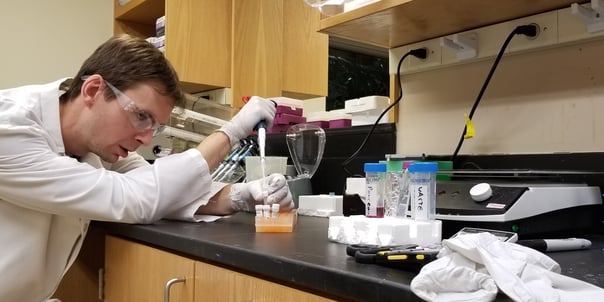So your experiments and data are funneling you down an inescapable path. You need to show direct gene regulation by your protein of interest. You think to yourself, “Oh, ChIP...”
Yes, chromatin immunoprecipitation, where even the assay name is long and daunting. However, take heart, keep your goggles on and your pipette loaded, because we can do this. See, I was once like you. I had never done a ChIP assay in my life. I did western blots and immunofluorescence. I worked exclusively with proteins. I was not really sure if nucleic acids were even a thing.

Questions mounted: How many cells do I need per IP? That many?! Can I use less? What about primary cells? What about tissues? Oh my, am I still only on step number 1? How many steps are in this protocol anyways?
Starting out, I probably made a mistake on every single protocol step. I sheared the chromatin too small. I did not shear the chromatin small enough. I used too much detergent in the shearing buffers, I used too little detergent in the shearing buffers. I didn’t add enough antibody in the IP step, I added too much antibody in the IP step (this actually can happen, by the way). Goldilocks would not have approved of any of my experiments.
One time, I even forgot to change out the spin columns during the DNA wash steps and spun my freshly isolated, ready-to-PCR ChIP DNA right into the ethanol waste, negating 2 days worth of benchwork (and 2 weeks worth of cell culture work). I worked with poor quality beads, spin columns, and PCR reagents, which compromised experiments through no fault of my own. Time and money is not something we have an abundance of in this field. At the peak of my frustration, I thought to myself, “Why, oh why, am I doing this?”
The answer to that question is actually simple. I made all those mistakes, and wasted all that time so you don’t have to. You, the reader of this blog. You, the seeker of truth and understanding. You, the scientist about to venture into a brave new world of chromatin immunoprecipitations. Cell Signaling Technology has kit-specific protocols that I helped develop and hone. We figured out what reagents were the best and included those in our ChIP kits. We found how many cells you actually need to get good, quality results. We discovered why our low detergent shearing buffers yield advantages over typical commercial grade buffers. We titrated all our antibodies to determine the optimal amount you will need for your experiments (this amount varies based on the affinity of the antibody itself). We know how many nanograms of IP’d DNA are needed to construct a ChIP-seq library. We know the answers to most of the questions that you may have because we were in the lab at the bench figuring it out for ourselves.
I’ve personally helped hundreds of people with their protocols. I’ve spent thousands of hours on the phone, writing emails, and analyzing user data. I ran over 80 chromatin IP’s per week for years, and have run hundreds of thousands of cycles of PCR. With all this experience comes knowledge, which we want to pass on to you. By using our ChIP kits and antibodies, you will be doing exactly what I did to get the figures on our datasheets. Sometimes when I was running low on reagents, I would literally run to our shipping department and rip open a kit box.
So I invite you to take a look around our website. Check out the protocols, ChIP kits, and antibodies we offer. Arm yourselves with all the tools needed to perform this ‘daunting’ assay. I went from being clueless, to competent, to helping troubleshoot for others. If I can do it, you can too. So if it turns out that you do need to show direct gene regulation, don’t worry. Keep ChIP’ing away. And if you need help, we are just an email or phone call away.

